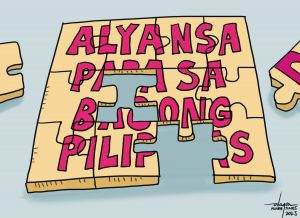We are glad to hear that not a single life was lost during last Wednesday night’s magnitude 5.2 earthquake that hit Davao City. At least, with a metropolis already at its present level of physical and economic development, it is lucky not to have suffered the fate of such cities as General Santos and Kidapawan, as well as some municipalities in Cotabato, Sultan Kudarat, Maguindanao, South Cotabato, Davao del Sur and Sarangani provinces.
What were reported as suffering some damage in Davao City, according to a report made by no less than Mayor Sara Duterte-Carpio are some school buildings that have shown cracks on the floors and walls. No public and private structures have collapsed.
However, what was drawn to the surface as a result of the strong earthquake is the still inadequate level of preparedness of the city’s disaster management group to make the residents react accordingly when disasters – man-made or natural phenomenon – happens.
No, we are not saying that our disaster managers and responders do not have the knowledge and skills to undertake their responsibilities when called upon. They are even well-equipped with modern devices and other equipment to further capacitate them.
What we believe is wanting in the city’s response system is the means to allow immediate communications to the people when disasters like flashfloods, tsunamis, and more importantly, earthquakes, occur.
Let’s take the case of the earthquake last Wednesday. Since such phenomenon can never be predicted when it would hit a particular place, the city’s regular conduct of drills seemingly sank in on the people. Those still inside buildings like offices and malls reacted instinctively using the buzz words duck, cover and hold.
Of course, that was on the first few seconds of the quake. In the succeeding seconds, videos were shared showing people inside buildings were rushing and crowding to wherever they can find. Outside, they located themselves in open spaces far from the buildings. And apparently, the lessons learned during the earthquake drills stuck in their minds. They stayed where they feel they could not be hit with debris should any structure collapse in the course of the temblor.
But what betrayed the weakness of the city’s disaster management and response program was the massive evacuation of residents to the nearest higher grounds of the city – the Shrine Hills which is also vulnerable to landslides during earthquakes.
The reason was the erroneous information peddled by unverified sources that a tsunami was about to hit the city. No one had any idea who started transmitting the wrong warning through the social media which reached everyone with capable communications gadgets as fast as lightning. In minutes the Shrine Hills were full of people. So massive was the evacuation that even the wake of a child was moved to what many believe is a safe place.
The evacuee spilled over to the C.P. Garcia Highway making the road almost impassable by motor vehicles.
Later in the evening the City Disaster and Risk Reduction Management Office (CDRRMO) announced to the public that it did not issue a tsunami warning. It even somewhat admonished the panicky public for evacuating without waiting for the blowing of sirens indicating the various stages during disasters. It went on to say that had the people bared in their minds the blasts of sirens are different in every stage like the halting but continuing sounds signaling evacuation, they would have been saved the trouble of moving out from their houses.
But why was the CDRRMO beaten to the draw in disseminating immediate and correct information related to the strong earthquake and its aftermath? Maybe it is because the reach of the siren blasts is so limited that only those residing in the immediate vicinity of the location of the warning equipment can hear. So, even if the CDRRMO has installed CCTVs in various coastal communities, disseminating information on the likelihood of a tsunami based on scientifically accepted signs, it can only reach so less.
And there is no denying the fact that information delivered through words of mouth even if it comes from legitimate source like the CDRRMO, could end up adulterated due to misinterpretation, and in some cases, deliberate for certain malicious intentions.
All these bring us back to our earlier recommendation for the local government of Davao City to operate its own radio station where everything about the city and what it is doing for the people will be the subject for discussion and dissemination. Primarily, of course, it should be the vehicle for disseminating information during times of disasters whatever its levels are.
Or, another option that we are suggesting is that the city enters into an agreement with the national government-owned radio and television station – dxRP and PTV 4 – to use its broadcast facilities for the city’s information, education and communication program. And when disaster happens, the government broadcast and television networks must preempt its national program to give way to local disaster advisories. This option, to us, is clearly doable and may even be less costly for the city.
We also do not doubt that using a broadcast station for continuous education of the people on disasters – what to do, where to seek shelter or evacuate, where to seek legitimate information and assistance, and how – is most effective and has wider reach.
With the city’s experience during the recent earthquake we are now throwing a challenge to the chair of the city council committee on information to look into the viability of each recommendation that we are putting forward and initiate its proposition in the plenary.
Shall the city wait for a disaster with some kind of a nuclear impact to happen before its leaders act?


